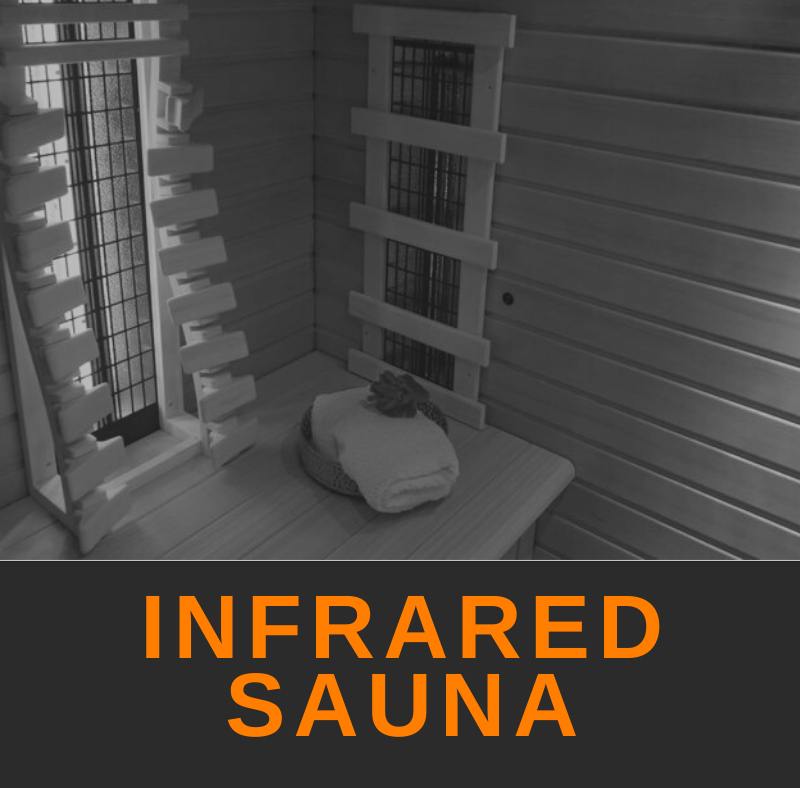
Infrared saunas promise a laundry list of benefits — from weight loss and improved circulation to pain relief and shedding of bodily toxins. Do the claims stand up to science? Read on!
Infrared Insight
Unlike traditional saunas, infrared heat directly warms the user’s body, not merely the surrounding air space. This advantage comes from the lamps’ conveyance of electromagnetic radiation, thereby enabling deeper tissue penetration. Operating at lower temperatures than traditional saunas (120 degrees versus 160 degrees), users remain comfortable for extended periods of time. Many infrared sauna fans embrace the opportunity to sweat and cleanse the body while minimizing exposure to excessive heat or vigorous exercise.
Effects on Recovery
A study undertaken in Finland looked at whether time spent in an infrared sauna following both hypertrophy training and endurance training might aid in the body’s recovery. The research team found a direct correlation to improved recovery only post-endurance training; those subjects who engaged in hypertrophy training lacked any additional recovery benefits following infrared treatment. Perhaps the ability of infrared heat to more deeply penetrate the body’s neuromuscular system could account for these results. Still, we cannot discount the relaxation achieved during minimal exposure to infrared light.
Parallel Perks
Not surprisingly, infrared saunas deliver many of the same benefits as their traditional counterparts. The serenity and relaxation that accompany sauna sessions supposedly boosts circulation. This in turn can potentially aid in muscle recovery and joint ailments, good news for those living with arthritis pain and the muscular/joint disturbances associated with chronic fatigue syndrome.
Some advocates believe that infrared saunas in particular improve immunity by facilitating the body’s shedding of heavy-metal toxins, though scientists remain somewhat skeptical.
Igniting Energy Engines
Zakia Rahman, MD, Clinical Associate Professor of Dermatology at Stanford University, believes that infrared saunas boost the body’s mitochondrial functioning.
“Mitochondria are the engines of each of our cells and this infrared light provides them with extra energy. Trees gain energy from light and our mitochondria do as well.”
The study of light science, known as photobiomodulation (PBM), needs additional scientific documentation before making more definitive claims on mitochondrial function. However, the infrared light sensitivity strongly suggests that PBM could prove useful in future medical and commercial applications. Suggested products to watch for on the horizon may include everything from fitness garments to bandages impregnated with infrared materials.
Science Skeptics Speak Out
Not all professionals adhere to the toxin-release theory. Dee Anna Glaser, a Professor of Dermatology at St. Louis University, chairs the International Hyperhidrosis Society, an organization focused on problems associated with excessive sweating. Dr. Glaser says, “Sweat can release some toxins and some chemicals, but that is not really sweat’s major job. The organs responsible for detoxifying our system are the kidneys and the liver. Those two do such a good job that, really, sweat doesn’t need to do that. So, for most people, sweating a lot does not detoxify them at all. Because the kidneys are doing it. Sweat’s main job is to keep us cool.”
Eric P. Widmaier, Hershel Raff, and Kevin T. Stang co-authored a book entitled Vander’s Human Physiology, and challenge the heavy-metal claims. The authors have yet to find qualified and extensive research on this topic. While minute quantities of lead, copper, and nickel may appear in sweat, they report, any presence of higher concentrations probably indicates the need for medical intervention.
Health Canada, an office within the Canadian Federal Government, studies the myriad of reliable research in its attempt to help citizens make prudent choices for overall wellness. Health Canada denies knowledge of any clinical evidence indicating that use of infrared saunas treats medical conditions, based upon review of several research studies into topics ranging from cancer and congestive heart failure to obesity. Furthermore, they stress refraining from substituting infrared sauna for accessing advice from a licensed medical doctor. Such practices might jeopardize a serious health condition.
General Safety Tips for Infrared Sauna Sessions
As with any traditional sauna experience, experts suggest using caution and practical common sense prior to infrared sauna use. Individuals living with chronic conditions requiring prescription medications, such as cardiac issues or hypertension, may wish to seek medical guidance regarding infrared sauna use in particular.
Hydrating well in advance of entering an infrared sauna helps with the inevitable sweating, as electrolytes get lost in this process. Coconut water seems to be an optimal choice, loaded with ample amounts of naturally-occurring potassium.Even minimal alcohol consumption can cause dehydration; therefore, experts advice refraining from imbibing before or immediately following sauna use.
Yoga-In-A-Hot-Box
Hot yoga, a new trend hitting the fitness scene several years ago, offers classes in studios with ambient temperatures approaching 105 degrees. Instructors of such classes claim students achieve a deeper level of flexibility. However, according to Dr. Cedric Bryant, the Chief Science Officer of the American Council on Exercise, the reports are purely anecdotal and not necessarily steeped in scientific fact.” Most traditional yoga studios maintain a temperature closer to 92 degrees, which Dr. Bryant deems sufficient to garner the cited benefits.
Still, hot yoga afficionados take the process a step further, choosing classes taught inside an infrared sauna, reporting increases in strength and circulation requiring less immersion time than traditional classes. Still, the concern regarding the negative effects of excessive heat on the body remains strong among medical professionals.
Advising Clients
Many clients look to personal trainers for advice on any number of fitness and health-related topics. Post-workout soreness seems to top the list, and sauna use will inevitably arise as a question of interest. By understanding the claims, the truths, and the potential side effects of infrared saunas, trainers remaining within their scope of professional practice can better advise clients on how best to embark on this “hot” adventure.
References:
pubmed.ncbi.nlm.nih.gov/26180741/
pubmed.ncbi.nlm.nih.gov/19602651/
europepmc.org/article/MED/23833705
pubmed.ncbi.nlm.nih.gov/25226343/
healthycanadians.gc.ca/recall-alert-rappel-avis/hc-sc/2019/70345a-eng.php
mayoclinic.org/healthy-lifestyle/consumer-health/expert-answers/hot-yoga/faq-20058057
mayoclinic.org/healthy-lifestyle/consumer-health/expert-answers/infrared-sauna/faq-20057954
healthline.com/health/infrared-sauna-benefits
healthline.com/health/under-review-infrared-saunas
theatlantic.com/health/archive/2017/06/infrared-saunas-will-not-detoxify-you-toxins-sweat/528813/
furthermore.equinox.com/articles/2017/04/infrared-saunas
byrdie.com/infrared-sauna-benefits






